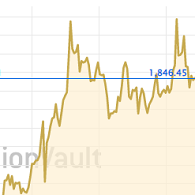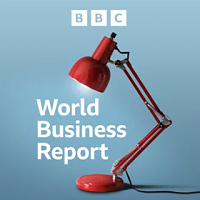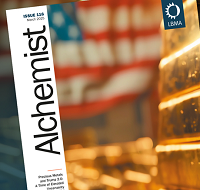SVB Crisis: Not Finished Yet?
Not judging by past crises, nor current stresses...
REMEMBER the Banking Crisis of March to May 2023? asks Jim Rickards
in The Daily
Reckoning.
It began with the collapse of the little-known Silvergate Bank on March 8. This was
followed the next day by the collapse
of the much larger Silicon Valley Bank (SVB) on March 9. SVB had over $120 billion in uninsured
deposits.
Bank deposits over $250,000 each are not covered by FDIC insurance. Those depositors stood to lose all
their money over the insured
amount. This would have led to the collapse of hundreds of startup tech businesses in Silicon Valley
that had placed their working
capital on deposit at SVB.
There were also much larger businesses such as Cisco
and at least one large
cryptocurrency exchange that had billions of Dollars on deposit there. Those businesses would have taken
huge write-downs based on the
size of their uninsured deposits.
On March 9, the FDIC said that indeed the
excess deposits were uninsured,
and depositors would get "receivership certificates" of uncertain value and zero liquidity
instead.
By March
11, the FDIC reversed course and said all deposits would be insured. The Federal Reserve intervened and
said they would take any US
Treasury securities from member banks in exchange for par value in cash even if the bonds were only
worth 80% of par (which most
were).
That Sunday night they also closed Signature Bank, a New York-based bank
with crypto links. The damage
wasn't done. On March 19, the Swiss National Bank forced a merge of UBS and Credit Suisse, one of the
largest banks in the world.
Credit Suisse was on the edge of insolvency.
Finally, on May 1, First Republic
Bank, with over $225 billion
in assets, was ordered closed by the government and sold to J.P.Morgan.
It was
the mother of all bailouts and
seemed to leave stock market investors unfazed. The issue was, and is: Once you've guaranteed every
deposit and agreed to finance
every bond at par value, what's left in your bag of tricks? What can you do in the next crisis that you
haven't already done – except
nationalize the banks?
After five bank failures in two months and a
trillion-Dollar bailout by the
government, the crisis seemed over. But that was false comfort. I wrote at the time that the crisis
wasn't over, that it was just
halftime.
Investors are relaxed because they believe the banking crisis is
over. That's a huge mistake.
History shows that major financial crises unfold in stages and have a quiet period between the initial
stage and the critical
stage.
This happened in 1994 when the spring bond market massacre seemed
contained in the summer only to
explode into the Mexican Tequila Crisis in December.
It happened in 1997-98
when the Asian financial crisis
calmed down in the winter of 1998 only to explode into the Russia-LTCM crisis the following August and
September.
It happened during the Global Financial Crisis when the original distress in August 2007
that seemed contained was
followed by the failures of Bear Stearns, Fannie Mae, Freddie Mac and Lehman Bros. from March to
September 2008.
The average duration of these financial crises is about 20 months. This new crisis began 12
months ago. It could have
eight more months to run, if not longer.
On the other hand, this crisis could
reach the acute stage faster.
That's because of technology that makes a bank run move at the speed of light. With an iPhone you can
initiate a $1 billion wire
transfer from a failing bank while you're waiting in line at McDonald's. No need to line up around the
block in the rain waiting your
turn.
In other words, the second stage of the crisis could erupt in even more
dramatic fashion sooner than
later. This slow-motion crisis can become a real-time crisis very quickly.
In
addition, the regulatory
response is faster because they've seen this movie before. That begs the question of whether regulators
are out of bullets because
they've already guaranteed almost everything so they don't have more rabbits to pull out of the
hat.
This
could be the crisis where the panic moves from the banks to the Dollar itself. If savers lose confidence
in the Fed (we're almost
there) not only will the banks collapse, but the Dollar will collapse also. At that point, the only
solution is gold
bullion.
It's also important to distinguish between individual bank failures
and a systemic banking crisis.
When individual banks fail, the depositors and creditors are usually protected but stockholders can get
wiped out.
In a systemic banking crisis, the contagion goes from bank to bank quickly, and the entire
system has to be rescued with
some combination of blanket deposit guarantees and unlimited QE.
In the worst
case, you either have to shut
the banks (which FDR did in 1933) or nationalize them which some countries have done from time to
time.
Either a single bank failure or a systemic crisis could happen at any moment. The actual trigger is a
bit mysterious and mostly
psychological because the fundamental problems have been there all along.
Well,
it seems that the quiet
period is over and we are entering Stage II of the banking meltdown.
New York
Community Bancorp (NYCB) had
taken huge losses of over $2 billion in February on its commercial real estate (CRE) portfolio. It had
been teetering on the brink
ever since.
On March 6, it was bailed out with $1 billion of new capital raised
by former Treasury Secretary
Steven Mnuchin and Ken Griffin's Citadel hedge fund. NYCB may have been bailed out, but it's the canary
in the coal mine.
Its failure means billions more in CRE losses are buried on bank books all over the
country.
The
bottom line is Stage II of the crisis is here, and the effects will be devastating to financial
institutions and the stock market as a
whole.
We may not be able to prevent the crisis, but we can see it coming and
prepare accordingly to preserve
our wealth. Step one is to get gold. That will see you through the storm.












 Email
us
Email
us
